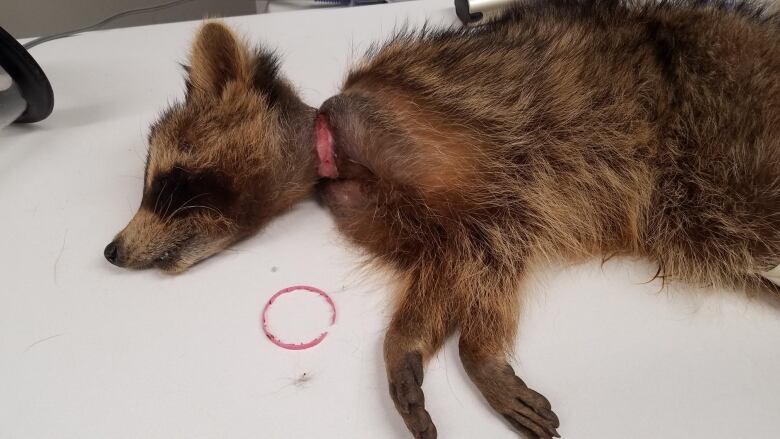Young raccoon on the mend after nearly strangling on plastic ring
Hope for Wildlife urges people to snip plastic rings to avoid another near-fatal incident

When a friend of Hope for Wildlife brought in a raccoon that was struggling to breathe, the Nova Scotia rescue centre figured it had gotten caught in a snare.
But when Dr. Jessica Khodadad investigated, she found something they'd never seen before: a plastic ring that was slowly strangling the raccoon.
Hope Swinimer, the founder of Hope for Wildlife, said the animal looks to be about a year old. She said the ring probably got struck around its neck when it was a baby.
"As the raccoon grew, it became more and more difficult for that raccoon to survive," she said Friday.
She thinks it was likely digging for food in human trash and the ring got caught around its neck. The animalmight have stuck its head in a food jar and pulled the ring out when it pulled its head out.

The raccoon's head soon grew bigger than the ring, trapping it around its neck. The ring had partially flatted its trachea and caused skin abrasions, but no permanent damage.
Snip plastic rings
They've named the raccoon Jim in honour of the man who rescued it, Jim Bell.
"And thank heavens he did, because when he drove it to us and got it under sedation and could take a look, we found the ring around the neck," Swinimer said.
Swinimer said people can prevent such incidents by snipping plastic rings before putting them in the trash or recycling. "Or better yet, don't buy them to begin with."

Bell lives near Crescent Beach in Lunenburg County. He first noticed the raccoon one evening in December as it ate seeds near his house.
"I could hear it wheezing and it would cough a bit," he told CBC News.
He saw it again a few weeks later, still wheezing.
He shone a flashlight on it and saw the neck fur was pulled forward to its face, and back to its body. Something was clearly constricting its neck. He, too, figured it was a snare.
He saw the raccoon again in the spring, and it was looking underweight and scruffy. He decided to try to trap it.
None of the traps he had were big enough, so he bought a new one that would "comfortably accommodate a raccoon."
He wired the door open and baited it with an apple to get the animal used to the trap. One night it approached the trap and took the bait. Bell, watching through a window in the dusk, held his breath.
Squirrels ruin the rescue
"And then all kinds of commotion started happening on the ceiling squirrels running around making a huge racket. It spooked the raccoon. It backed out of the cage and went down over the hill," Bell said.
He sat for another hour as darkness fell. He set up his infrared video camera and went to bed.
He awoke to find the raccoon in the trap. He drove it to Hope for Wildlife, a trip he's made many times over the last decade or two.
Hope for Wildlife expects the raccoon will make a full recovery and return to the wilds of Lunenburg County this summer.
"It's good we got it when we did," Swinimer said. "He's still able to eat and drink and he's behaving normally aggressively like he should be. I think we're lucky in this case."
MORE TOP STORIES












_(720p).jpg)


 OFFICIAL HD MUSIC VIDEO.jpg)
.jpg)



























































































